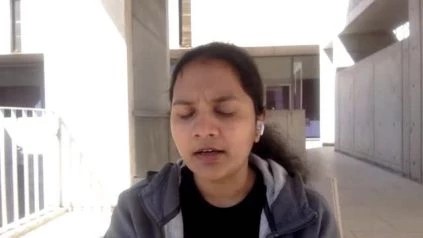Professor Tony Hunter, Ph.D., and Rajasree Kalagiri, Ph.D. of the Salk Institute for Biological Studies discuss the article Salk team reveals never-before-seen antibody binding, informing both liver cancer and antibody design.
Link to Article –
https://www.salk.edu/news-release/salk-team-reveals-never-before-seen-antibody-binding-informing-both-liver-cancer-and-antibody-design/
LA JOLLA (AP) — Some molecules in structural biology are so rare that they can only be captured using a specific collection of methods. That’s how a multi-institutional research team led by Salk scientists identified how antibodies recognize phosphohistidine, a highly unstable molecule implicated in cancers including liver and breast cancer and neuroblastoma.
These findings will not only allow scientists to conduct more advanced research on phosphohistidine and its possible function in cancer, but they will also allow them to modify the form and atomic composition of antibodies’ binding sites in the future, allowing them to create ever more effective antibodies. On February 5, the thesis was published in the Proceedings of the National Academy of Sciences.
A phosphohistidine analogue (ball and stick model) nestled at the interface between different areas of a phosphohistidine antibody (green, brown). Such structures provide information about the antibodies’ molecular properties, making them useful for detecting phosphohistidine-containing proteins in cells.
A phosphohistidine analogue (ball and stick model) nestled at the interface between different areas of a phosphohistidine antibody (green, brown). Such structures provide information about the antibodies’ molecular properties, making them useful for detecting phosphohistidine-containing proteins in cells.
Proteins are made up of amino acids that are bound together in precise sequences, and some of them may undergo chemical transformations that alter the protein’s function for the better or for the worse. Phosphorylation is a change that occurs when a phosphate compound is added to an amino acid, altering its shape and charge. Hunter previously demonstrated that phosphorylation of the amino acid tyrosine would promote cancer progression, a finding that led to the development of a number of anticancer drugs. Hunter has recently focused on the phosphorylation of the amino acid histidine (which results in the formation of phosphohistidine), suspecting that the mechanism might also play a role in human disease.
Hunter produced a series of monoclonal antibodies that could identify phosphohistidine analogues, which were chemically stable phosphohistidine analogues. The next move was to figure out how the antibodies were able to bind to phosphohistidine in the first place. Hunter decided to study the structures of phosphohistidine antibodies with Ian Wilson, the Hansen Professor of Structural Biology at the Scripps Research Institute and a world-renowned expert in using protein crystallography to describe antibody structures.
They wanted to imagine their antibodies in the act of binding the phosphohistidine, so they formed crystals between each antibody bound to a phosphohistidine peptide to figure out how phosphohistidine is recognized.
The team solved two types of antibody crystal structures, revealing how various amino acids are organized around the phosphohistidine to tightly bind it. Their five structures are more than double the number of previously recorded phospho-specific antibody structures, and they reveal how antibodies recognize both the phosphate and the related histidine. They also show how the two types of antibodies recognize different forms of phosphohistidine on a structural level, which will enable scientists to engineer better antibodies in the future. ​
Salk’s Jill Meisenhelder and Stephen R. Fuhs, the Scripps Research Institute’s Robyn Stanfield, and the University of California San Diego’s James J. La Clair were among the study’s other contributors.
The National Cancer Institute, the Leona M. and Harry B. Helmsley Charitable Trust, and The Scripps Research Institute’s Skaggs Institute for Chemical Biology all contributed to this research.

